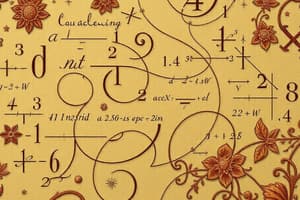Podcast
Questions and Answers
What is the characteristic shape of the graph represented by a quadratic equation?
What is the characteristic shape of the graph represented by a quadratic equation?
- Parabola (correct)
- Straight line
- Hyperbola
- Circle
Which method is used to solve a quadratic equation by rewriting it in a perfect square form?
Which method is used to solve a quadratic equation by rewriting it in a perfect square form?
- Factoring
- Completing the square (correct)
- Using the quadratic formula
- Graphing
What is the condition for a quadratic equation to have real roots?
What is the condition for a quadratic equation to have real roots?
- At least one coefficient is negative
- The leading coefficient is positive
- The product of coefficients is zero
- The discriminant is greater than or equal to zero (correct)
In the program, what value does 'r' represent after the statement 'r=a/f'?
In the program, what value does 'r' represent after the statement 'r=a/f'?
What is a likely consequence of using scaled coefficients in quadratic evaluations?
What is a likely consequence of using scaled coefficients in quadratic evaluations?
During root calculation, the program checks whether 's' is greater than zero. What does this determine?
During root calculation, the program checks whether 's' is greater than zero. What does this determine?
What does the variable 'error' signify in the provided program?
What does the variable 'error' signify in the provided program?
What is the significance of the statement 'if (a==0) STOP' in the program?
What is the significance of the statement 'if (a==0) STOP' in the program?
Flashcards
Quadratic Equation
Quadratic Equation
An equation of the form ax² + bx + c = 0, where a, b, and c are constants (numbers), and x is an unknown variable. 'a' cannot be zero.
Roots of a Quadratic Equation
Roots of a Quadratic Equation
The values of 'x' that satisfy the equation. There are typically two roots.
Quadratic Formula
Quadratic Formula
A formula that directly calculates the roots of a quadratic equation: x = (-b ± √(b² - 4ac)) / 2a
Factoring a quadratic
Factoring a quadratic
Signup and view all the flashcards
Completing the square
Completing the square
Signup and view all the flashcards
Loss of Significance
Loss of Significance
Signup and view all the flashcards
Scaled Coefficients
Scaled Coefficients
Signup and view all the flashcards
Numerical Stability
Numerical Stability
Signup and view all the flashcards
Study Notes
First Numerical Problem
- Topic: Numerical problem for MAP Department/EARIST Manila
Content
- Topic: Topics for the course
- Subjects: Quadratic Equation, 1st Order Differential Equation, Euler's Method, An Introduction To Files And File Processing, Radioactive Decay
Quadratic Equation
-
Definition: A quadratic equation is a mathematical equation containing a variable of degree 2.
- Derivation: Derived from the Latin word "quadratus" meaning "square."
- Variable Identification: The equation involves one unknown variable, 'x', and known coefficients (a, b, and c), and a ≠ 0.
- Solutions: Characterized by having two solutions or roots.
- Real or Complex Coefficients: Roots resulting from real or complex coefficients (can be distinct or identical).
- General Formula: The equation can be expressed using the quadratic formula: x = (-b ± √(b² - 4ac)) / 2a
- Additional Information:
- Graphical Representation: The equation can be represented by a parabola which opens upwards or downwards with reference to a, b, c and the x and y axis.
- Vertex Coordinates: The coordinates of the vertex of the parabola can be identified using the equation.
-
Solved Methods:
- Factoring by Inspection
- Completing the Square
- Using the Quadratic Formula
Avoiding Loss of Significance
- Techniques:
- Finding the largest value: Lines 19-22 use MAX to determine the highest coefficient value.
- Faster calculations: Scaled coefficients are more efficient assuming the coefficient's magnitude is similar.
- Close roots treatment: Line 29 is designed for scenarios involving roots that are nearly identical in value.
- Approximation: Scaled coefficients are approximations, potentially sacrificing precision but enhancing calculation efficiency.
1st Order ODE
- Topic: Review of first-order ordinary differential equations (ODEs)
- Equations: Differential equations involving first-order derivatives.
Differential Equation
- Definition: A differential equation incorporates derivatives of one or more functions, including 1, 2, 3, 4, 5 & 6.
Differential Equation (Detailed)
- Definition: Equations describing dynamic systems by relating a function's rate of change to its dependent variables.
- Information Foundation: Begins with knowledge of the system's rate of change and aims to determine the function governing the changes.
Derivative Notations
- Leibniz notation
- Lagrange notation
- Newton notation
Order of Differential Equation
- Definition: The highest derivative order. Orders: 1, 2, 3, 4, 5 & 6
Solution of a Differential Equation
- Solution Characteristics: Requires a function satisfying the given differential equation, where the function's first derivative is continuous within a specified interval.
- Function Requirements: Continuous first derivative, defined for a given interval, satisfies the condition(s)
Ordinary Differential Equations
- Characteristics: Involve ordinary derivatives in terms of single independent variables (example: rate of change in a system relating to time)
- Orders: 1, 2, 3
Solving a Differential Equation (Example)
- Process: Involves three steps:
- Solve for the integral parts
- Apply the rules for variable changes and any specific rules related to particular function types
- Substitute solution into the equation to check its validity/correctness
Solving a Differential Equation (Question)
- Question: Determine the number of solutions.
- General Solution: A family of functions (a set of similar functions).
Particular Solution
- Obtaining Solutions:
- Specific values of arbitrary constants from the general solution result in a particular solution.
- Solving for the constants using given initial conditions/boundary conditions
Direct Integration
- Method: Straightforward integration to find solutions for a particular type of differential equation.
- Condition: Right-hand side must be a function of only the independent variable.
(Example 1-3) Direct Integration
- Process: Solving differential equations using integration techniques; detailed instructions are missing or incomplete.
1st Order ODE
- Topic: First-order ordinary differential equations (ODEs)
- Types: Separable variable, homogeneous, exact, linear; related methodologies and specific examples are required to further clarify topics.
Variable Separable Method
- Equation Form: General form of an equation that can be solved with direct integration.
Homogeneous Equations
- Function Representation: Homogeneous functions of a particular degree, involving a specific scaling (tx and ty) rule.
- Characteristics: First-order differential equations that can be altered, simplified and solved; methodology, steps, and examples expected.
Homogeneous Equations (Continued)
- Substitution Method: Reframing variables (substitute y = vx) to facilitate separable-variable solutions.
Homogeneous Equations (Example)
- Example equation: Solving a differential equation, using the above homogeneous equation methodology
Euler's Method
- Introduction: Mathematical technique to approximate solutions to differential equations.
- Basis: Local linearity approximation through iterative procedures.
- Requirements:
- Differential Equation: Need a differential equation (example: dy/dt = f(t,y) format)
- Initial Point: A starting point (t₀, y₀) on a particular solution graph. This value relates to the dependent variable equation's solution at a specific time.
- Step or Increment Size: A fixed constant for incremental calculation.
Local Linearity & Approximation (Euler's Method)
- Basis: The slope at a point (calculated from the differential equation) approximates the curve's behavior at the given time.
- Illustration: A diagrammatic representation of the local linearity approximation in Euler's method.
Implementing Euler's Method
- Steps Required: Instructions for applying Euler's method, procedures, calculations, and necessary components like fixed step size and expression for dependent variable and independent variable.
Euler's Method (Another Example)
- Specific values using Euler's Method at different time points using given values and methods presented in the documentation for calculating time, temperature and dewpoint.
Using Euler's Method
- Application: Approximating y(0.3), applying Euler's method with a step of 0.1, and solving a given initial value problem.
- Numerical Values Required: A given table of data values. Example Values (x,y) are provided and require the calculation of y values at specified time intervals (using Euler's technique and given data).
An Introduction to Files and File Processing
- Files: Organized data units outside of the computer's main memory (RAM): The file is used for data storage that is not currently used in computations or programs.
- Records: Data segments with organized sequences for file structures. File Records are individual pieces of data within a file. Each record in the file is read either individually or sequentially, dependent upon the program's design.
- Access methods: Sequential Access, Direct Access (can access individual records without accessing preceding records).
Secondary Memory
- Computers' secondary storage: Location for programs and data not currently in use.
Input/Output Unit
- Unit Designations: Unit numbers (asterisks or numerical values) representing input/output devices or channels.
Number, Asterisk, Name
- Function Descriptions: Explanation of how different units/methods of representing a file are used in computer programs.
File Processing: OPEN (open-list)
- OPEN Components: Structure of the open statement and the clauses (UNIT, FILE, STATUS, ACTION, IOSTAT)
- Variable Meaning: Explanations about the functions/uses/meaning of different variables/keywords in file processing (examples: STATUS, UNIT and FILE)
File Processing: OPEN (open-list) - Continuation
- OPEN Details: Clarification on further specification associated with the open function/statement (eg., action, position, etc).
CASE 1: OPENING A FILE FOR INPUT
- File Opening: How to open a file for input using an OPEN statement, including explanations and example code.
File Processing: CLOSE (close-list)
- Closing Procedures: Clarification on file closing, including the different clauses.
WRITE (output-list)
- WRITE Commands and their clauses (including FMT, ADVANCE, etc.).
READ (input-list)
- READ Statements and Clauses (similar to WRITE, explaining clauses, variables and formats).
File Input/Output
- File Handling: How FILE statements are handled.
- Error Handling: Procedure for handling possible errors or the end-of-file conditions (EOF).
REWIND/BACKSPACE
- Commands: Function of rewind/backspace directives.
Example Program
- Sample Codes: Practical examples of files' (for input/output) handling.
Studying That Suits You
Use AI to generate personalized quizzes and flashcards to suit your learning preferences.
Related Documents
Description
Test your understanding of quadratic equations in this quiz. Explore key concepts such as their characteristic shapes, methods for solving them, and conditions for real roots. This quiz will help clarify common programming implementations related to quadratic evaluations.




